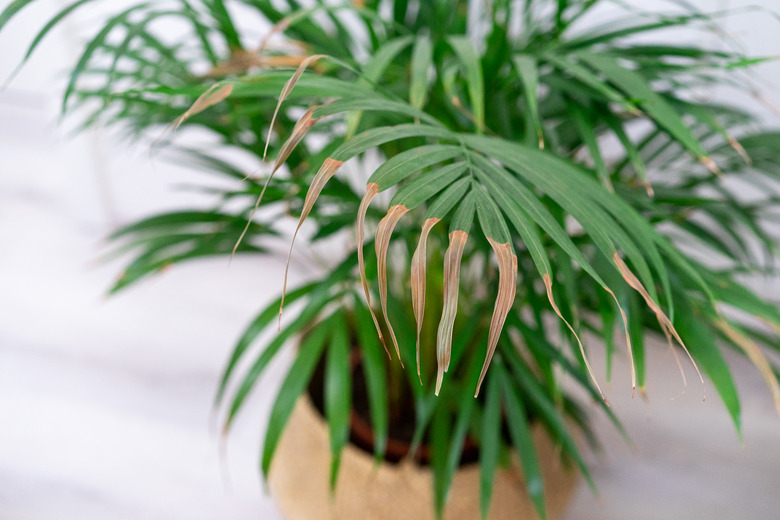Why Are My Cat Palm Leaves Turning Brown?
We may receive a commission on purchases made from links.
Cat palms (Chamaedorea cataractarum, USDA zones 10-11), also called cataract palms and cascade palms, are originally from the jungles of Central America where they grow on stream banks. Cat palms add a lush tropical accent to outside landscaping in warm weather locations such as some regions of California and South Florida; in harsher climates, they are kept as dramatic houseplants, and are often moved outdoors in summer to beautify terraces and patios. If your cat palm has fronds that are turning brown, there are techniques you can use to identify the problem, correct it, and restore your plant to verdant health.
How to Fix Brown Leaves on Cat Palms
How to Fix Brown Leaves on Cat Palms
Though brown leaves on any plant can be alarming for a home gardener, there are many remedies you can try to fix the problem:
Look for Salt
Look for whitish deposits in the soil around your cat palm, an indication of harsh salts in hard tap water, and a common cause of browning leaves in cat palms. If you see the deposits, leach out the salts by drenching the soil until water runs out the bottom of the container, and repeating many times in succession. If you have hard water, use only distilled water for watering and misting your cat palm in the future.
Check for Spider Mites
Check the undersides of your cat palm's fronds for cobwebby material, a sign of spider mites. Cat palms are extremely susceptible to these tiny pests, and can even die from a bad infestation. Use a magnifying glass to confirm the presence of the miniscule, reddish-brown mites. Treat by spraying forcefully with a hose to knock the mites off, and mist your cat palm daily to discourage further infestation as spider mites thrive in hot, dry conditions.
Look for Mealybugs
Examine your cat palm for the presence of mealybugs, which cause yellowing and then browning of leaves by sucking the juices from the plant. If your cat palm has mealybugs, you will see small, oval cottony dots on the leaves. Spray mealybugs with a half-and-half mixture of isopropyl alcohol and water.
Inspect for Scale Insects
Check for roundish, waxy bumps on stems of fronds, a sign of scale insect infestation. Smother the scale with ultra-refined horticultural oil or simply flick them off plants with a plastic card.
Fertilize Cat Palm Appropriately
Fertilize your cat palm three to four times a year using a 12-4-12 formulation palm fertilizer. This helps treat brown leaves caused by insufficient nutrients in the soil.
Mist Cat Palm
Mist your cat palm daily with lukewarm, distilled water to prevent the dryness that causes browning; cat palms need a lot of humidity to thrive. Don't place your cat palm near a heating or air conditioning vent as the air will be too dry.
Ensure Proper Lighting
Evaluate the light you are giving your cat palm; both insufficient light and too much light can contribute to brown leaves. Cat palms are understory trees in their native environment and need filtered light. Mature, well-established cat palms can tolerate direct sun, but too much sun can scald the leaves. Move your cat palm to an area with different lighting, if possible, to alleviate the problem.
Water Cat Palm Enough
Water your cat palm until water runs out the bottom of the drainage holes to guard against under-watering, manifested by leaf tips turning brown. Avoid overwatering as well. Dump out any extra water in the saucer to avoid keeping the soil overly wet.
Trim the Brown Tips
Although trimmed leaves won't turn green again, trimming the brown tips off with sharp, clean scissors can improve the plant's appearance.
